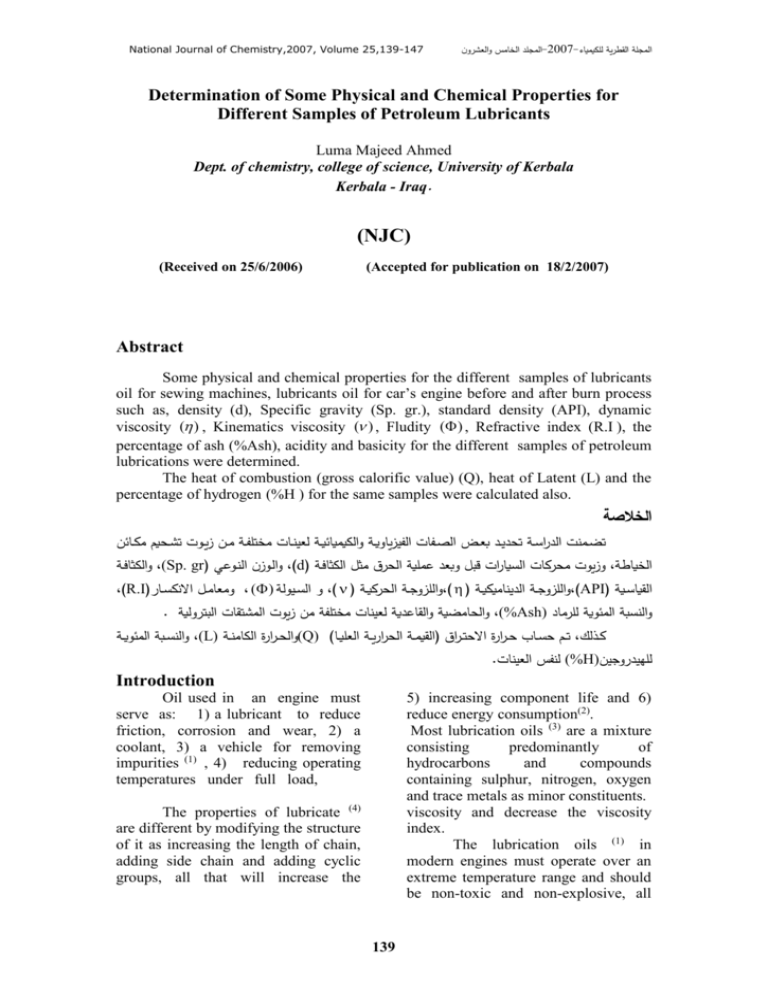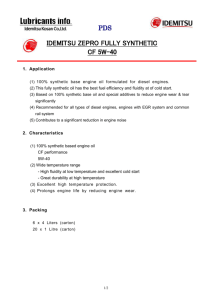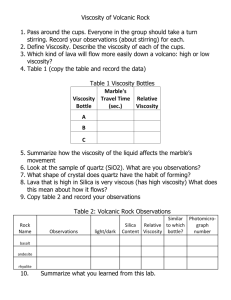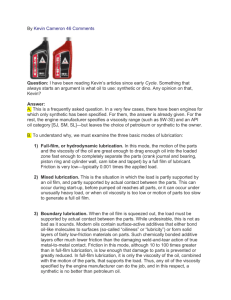Determination of Some Physical and Chemical Properties for
advertisement

National Journal of Chemistry,2007, Volume 25,139-147 المجلد الخامس والعشرون-7002-المجلة القطرية للكيمياء Determination of Some Physical and Chemical Properties for Different Samples of Petroleum Lubricants Luma Majeed Ahmed Dept. of chemistry, college of science, University of Kerbala Kerbala - Iraq. (NJC) (Received on 25/6/2006) (Accepted for publication on 18/2/2007) Abstract Some physical and chemical properties for the different samples of lubricants oil for sewing machines, lubricants oil for car’s engine before and after burn process such as, density (d), Specific gravity (Sp. gr.), standard density (API), dynamic viscosity ( ) , Kinematics viscosity ( ) , Fludity ( ) , Refractive index (R.I ), the percentage of ash (%Ash), acidity and basicity for the different samples of petroleum lubrications were determined. The heat of combustion (gross calorific value) (Q), heat of Latent (L) and the percentage of hydrogen (%H ) for the same samples were calculated also. الخالصة الصممتاا التعاياويممة والكيميا يممة لعع مماا مختلتممة مممن ايمموا تشم ي مكمما ن تضممم ا الد ار ممة ت دعممد ع م والكثافمة،(Sp. gr ( والموان ال موع،)d وايوا م ركاا ال ياراا قبل و عد عملية ال رق مثل الكثافمة،الخياطة ،)R.I ومعامممل اك ك ممار، ( ) و ال ممعولة،) واللاوجممة ال ركيممة،) واللاوجممة الدع اميكيممة،)API القيا ممية . وال امضية والقاعدية لعع اا مختلتة من ايوا المشتقاا البترولية،(%Ash) ة الم وية للرماد وال م ة الم ويممة،(L) مررق الكام ممة (وال م اQ) )مماة م اررق اك ت مراق القيمممة ال ارريممة العليمما وال ت م، كممكل .( ل تس العع اا%H)للهعدروجعن Introduction Oil used in an engine must serve as: 1) a lubricant to reduce friction, corrosion and wear, 2) a coolant, 3) a vehicle for removing impurities (1) , 4) reducing operating temperatures under full load, 5) increasing component life and 6) reduce energy consumption(2). Most lubrication oils (3) are a mixture consisting predominantly of hydrocarbons and compounds containing sulphur, nitrogen, oxygen and trace metals as minor constituents. viscosity and decrease the viscosity index. The lubrication oils (1) in modern engines must operate over an extreme temperature range and should be non-toxic and non-explosive, all The properties of lubricate (4) are different by modifying the structure of it as increasing the length of chain, adding side chain and adding cyclic groups, all that will increase the 139 National Journal of Chemistry,2007, Volume 25,139-147 that will prove by employing additives such as (5, 6) antioxidant (amines, phenols), corrosion inhibitor, detergent and dispersant (Ca, Ba compounds, soaps), alkalinity (Ca, Ba hydroxides), antibacterial (biocides), Oiliness or wetting agents (fatty oils, chlorinated wax), Extreme pressure agents (organic compounds of Cl, S, P (hydraulic, gear oil)), pour point depressant (organic polymers), antifoam (silicanes), viscosity index المجلد الخامس والعشرون-7002-المجلة القطرية للكيمياء improvers (organic polymers) and emulsifying agent (polar compounds). The lubrication oil used as a cheap source of fuel to the urban poor enterprises and households by employing drip method(7). The characteristics of lubrication oil depended on its crude oil. It is different from oil field to other oil field, that indicated to different in a constituation of it, that was explained in the table(A):(8,9) Table (A): The element Composition in (Wt % ) range for crude oil The elements Carbon Hydrogen Sulfur Nitrogen Oxygen Metals Element composition Wt % range 83.9 - 86.8 11 - 14 0.06 - 8 0.02 - 1.7 0.08 -1.82 0.0 - 0.14 543 723) K C n H m 9 H 2 ( 2C n H m The many researchers studied how to increase the ratio of hydrogen to carbon in petroleum to increase the product energy, according to the (10following equation 12) . Mrena and Coworkers(13) found the some physical and chemical properties of lubrication oils like net calorific value, gross calorific value Sp.gr at 30 and 60oC , viscosity at 30 and 60oC ……etc. (14) Hamdon produced the activated carbon from spent Lubricating oil by employing oxidation condensation process. Hendy and Coworkers(15) studied the chemical changes which occurred in oil emulsion by the action of eight different species of bacteria isolated, that changed the standard o 5 a 2 a=constant depended on the type of hydrocarbon product. engineering performance for oil emulsion and increased the rust formation and corrosion of steel samples. Experimental Part A- Instruments: The employed instruments are:1) Digital balance (Sartorius, Bp- 2015-Germany). 2) Water bath, (W 350Germany). 3) Refrectrometr, (Atago 1TJapan). 4) Furnace, (mke- Pe 100 – Canada). 140 المجلد الخامس والعشرون-7002-المجلة القطرية للكيمياء National Journal of Chemistry,2007, Volume 25,139-147 B-Materials and Procedure: Six samples were studied, according to the table (B): No . 1 2 3 4 5 6 Sample Lubricants oil for sewing machines Lubricants oil for sewing machines Lubricants oil for sewing machines Lubricants oil for car’s engine before burn Lubricants oil for car’s engine before burn Lubricants oil for car’s engine after burn Countries Colour Iran Iraq Iraq Germany Iraq Iraq Pale- yellow Light- yellow Brown –yellow Yellow-brown Green- brown Black-brown *The mechanical properties were determined such as, density (d), specific gravity (Sp. gr.), standard density (API), dynamic viscosity ( ), kinematics viscosity ( ) and fluidity ( ) . The densities(d) ( at 15 oC and 38 oC) were measured by pyknometer method according to the equation(1) (16): d msample D.W mD.W D.W = the densities of D.W. ( at 15 o C 38 o C) and ............(1) The specific gravity was found by equation (2)( 13 ): Sp.gr. d sample D.W at (15) C ................(2) The degree (API) gravity was determined at 15 oC by American Petroleum Institute of the following equation (17,18): API Scale 141.5 131.5 Sp. gr . (15 C) ..............(3) Dynamic (absolute) viscosity ( )(16) is determined by the time of flow of studied samples and D. W at 38 oC. sample d sample x t sample D.W x t D .W .................(4) D .W The kinematics viscosity ( )(19)is calculated by dividing the dynamic viscosity ( ) to the density (d) at 38 oC. d ( at 38 o C) 141 ..........(5) National Journal of Chemistry,2007, Volume 25,139-147 المجلد الخامس والعشرون-7002-المجلة القطرية للكيمياء The fluidity ( ) was calculated by employing equation(6)(16,19) 1 ( at 38 o C) ..........(6) * The optical property, refractive index (R.I) was measured at 20 oC by employing Abbi refractometer, so the R.I is regarded as an indicator of light- colored liquid petroleum products (20). *The acidity and basicity were measured by titration method (21): mmole of base = mmole of sample ………(7) *The hydrogen content (%H ) was calculated by following equation(.22): % H 26 (15 x Sp. gr.) (at 15 o C (60 o F)) ............(8) *The thermal property, heat of combustion (gross calorific value) (Q) and heat of Latent (L) were calculated by equations (9,10)( 23): Q 12400 (2100 ( Sp.gr ) 2 ) 1 L (110.9 0.09 t ) Sp.gr (at 15 o C (60 o F)) ..............(9) (at t 60 o F) ..............(10) *The % Ash was measured by following equation (11) (24): % Ash Wsample after burn ( g ) Wsamplebefore burn ( g ) 100 ............(11) Results and Discussion Table(1-A): Some mechanical properties (d, Sp.gr & API) for studied samples at ( t 15 1 o C ) No. of samples 1 2 3 4 5 6 Density (g/ mL) 0.88577 0.85178 0.86746 0.91877 0.98581 0.92177 Specific gravity (Sp. gr) 0.87354 0.84001 0.85548 0.90608 0.97219 0.90904 API 30.4845 36.9503 33.9042 24.6672 14.0476 24.1587 * D.W =1.0140 gm/mL From the previous table, the sp. grs for all samples were approved with the standard range (25) (0.85 – 0.97) except sample (2) due to presence of a low amounts of nephthene compounds (24) . The sp.gr of sample (6) was low compared with sample(5) that 142 National Journal of Chemistry,2007, Volume 25,139-147 beyond to break its molecules during the burning process at 260- 400 oC in engine of car which cause the dissociation of its(26). المجلد الخامس والعشرون-7002-المجلة القطرية للكيمياء According to the standard range for API ( >15) (23, 25, 27), that refereed to approve with the API for all samples except sample (5) due to the same reason. Table(1-B): Some Mechanical Properties ( d , , , ) for studied samples at ( t 38 1 o C ) No. of samples 1 2 3 4 5 6 ( ) Poise 0.6740 0.3700 0.3955 1.2176 2.0108 1.4559 Density (g/ mL) 0.8084 0.8482 0.8648 0.8728 0.9143 0.6390 ( ) cSt 83.3745 43.6215 45.77326 139.5050 219.9278 227.84037 ( ) poise-1 1.4836 2.7027 2.5284 0.8212 0.4973 0.6868 equilibrium matters matter(29, 30). and D.W = 0.99497 gm/mL According to the results in table (1-B), the density is decreased with the temperature, because oils are expansion with increased temperature(28). emulsion The sample 6 was had a high value of Kinematics viscosity that due to corrode the iron of engine’s car during the burning processes. In general, the standard range for kinematics viscosity equal (15-150 cSt)(23 ). But the kinematics viscosity for samples (5) is very high, may be a cause for the amount and the nature of additives which add as anti-oxidant, anti-corrosion, anti-microbiology, The fluidity of sample (3) is more than fluidity of sample (5), that referees to a low dynamic viscosity. Table(2): The optical properties (Colour and refractive index) for studied sample at ( t 20 o C ) No. of samples 1 2 3 4 5 6 Colour Pale yellow Light yellow Brown-yellow Yellow- brown Green-brown Black-brown 143 R.I At 20oC 1.474405 1.472405 1.473405 1.462038 1.494540 - National Journal of Chemistry,2007, Volume 25,139-147 According to the results in table(2), that occurred the values of R.I of samples 1,2 and 3 were very close to each other, because they are light oils which used as lubrication for sewing machine. المجلد الخامس والعشرون-7002-المجلة القطرية للكيمياء of they were employed in lubrication process for the car's engine, that may be a cause to the amount and the nature of additives (29, 30). The sample 6 wasn’t showed a value of R.I that beyond to corrode the iron of engine’s car during the burning processes with the time. But the R.I for sample 4 is smaller than R.I for sample 5, in spite Table (3): The values of basicity and acidity for the studied samples at ( t 30 o C ). No. of samples 1 2 3 4 5 6 Basicity M - Acidity M 0.0100 0.0020 0.0016 0.006 0.002 0.094 According to results in table (3), the values of acidity were most lower to prevent the corrosion process in sewing machine and car engine. compounds as result to react the lubricant with atmosphere oxygen during burned it in engine car, to give peroxide compound(24, 31), the increase in acidity will cause the corrosion in engine’s car therefore, the spent lubricating oils will replace(32, 33).. The acidity for sample 6 was highest than acidity for other samples, that beyond to exist some oxygen Table(4): The values of percentage for %Ash of studied samples. No. of samples 1 2 3 4 5 6 %Ash 0.860 0.280 0.592 30.120 25.020 26.080 144 National Journal of Chemistry,2007, Volume 25,139-147 المجلد الخامس والعشرون-7002-المجلة القطرية للكيمياء From table(4) the results referred that %Ash are greater than the standard range (< 0.1)(22), due to presence of higher amount of inorganic metal like (Ni, Zn ….etc.) (24) during separation and purification processes in refineries. Table(5): The values of thermal properties (L, Q and %H) at ( t 15 oC, 60 o F ) No. of samples 1 2 3 4 5 6 L Btu. Pound-1 121.554 126.622 124.234 116.995 134.591 116.596 Q Kcal.Kg-1 10797 10876 10863 10674 10415 10664 Btu(34) :Britain temperature unit = 778 ft. Ib. According to the results in table (5), the %H in all samples were within the standard range(2) (11.8-13.3) except sample (5) due to additives. The heats of combustion for all samples were within standard range(23) (10504- 10882) Kcal. Kg-1 except sample (5), due to its high sp. gr(22). The heats of latent for all samples were fixed with the standard range (23) (111124) Btu. Pound-1 except sample (5)(22) due to the same reason. 145 %H 12.8960 13.3998 13.1670 12.4088 11.4171 12.3644 National Journal of Chemistry,2007, Volume 25,139-147 المجلد الخامس والعشرون-7002-المجلة القطرية للكيمياء 4- E. F. Obert, Internal Combusion Enginers and Air Pollution, 3rd ed., Harper and row, New York, 1973. References 1- W. W. Pulkrabek, Engineering Fundamentals of the Internal Combustion Engine, Prentic Hall, USA, 1997. 5- Y. C. Tuck, Marine engineer word, Lubrication oil, WWW. Practicingdanalysis. Com, 2004. 2- D. Laue, Machinery Lubrication Magazine, May, 2001. 6- T. Yoon, Marine engineer word, Additives that improve lubrication oils, WWW. Freemarine. Com and WWW. Freeengineering.com., 2006. 3- F. J. Villforth, Lubricants and Librication¸8th ed., Mc Grow Hill, 1978. 7- H. T. Kimweri, Technical and Environmental assessment concering the Technology of Utilization of waste oil as fuel, Dar es Salaam, 1993. hydrogen, Int. J. Hydrogen energy, 1986, 11, 1301. 13- G. D Mrema, P. P. Van Schijndel and F. J. Janssen, IET (Institution of Engineers Tanazania), 2000. 8- G. D. Hobson and W. Pohl, Modern Petroleum Technology, 4th ed., Applied Science Publishers LTD., 1975. 14- A. A. Hamdon, Nati. J. of Chem., 2005, 18, 216. 15- W. A. Hendy, N. K. Al-Hadary and A. K. Hendy, Nati. J. of Chem., 2002, 8, 510. 9- C. F. Mabery, Ind. Eng. Chem., 1923,15, 314. 16- O. F. Steinbach and C. V. King, Experimental in Physical Chemistry, American BookCompany, New York, 1950.. 10- W. Balthasar, Hydrogen Production and Technology: Today, Tomorrow and beyond, Int. J. Hydrogen Energy, 1984, 9¸ 649. 17- Annual book of IP standard, Density and relative density, 14th ed, 1981, Vol. 1, IP 59. 11- C. W. Bowman, M. P. Duplessis, The Canadian Synthetic Fuel Industry- A. Major user of hydrogen, Int. J. Hydrogen Production, 1986, 11, 43. 18- Annual book of IP standard, Standard method of test for density, specific gravity, or API gravity of crude petroleum and liquid petroleum products, 14th ed., 1981, Vol. 1, IP 160. 12- K. Wlesener, The Chemical and Industrial use of 146 National Journal of Chemistry,2007, Volume 25,139-147 20- A. L. Ward and S. S. Kurtz, Ind. Eng. Chem., 1938, 10, 559. 19- A. Findlay, Practical Physical chemistry, 18th ed., Longmans, London, 1966. 21- المجلد الخامس والعشرون-7002-المجلة القطرية للكيمياء L. G. Hargis, Analytical chemistry, principles and techniques, prentice-Hall, Inc., London, 1988. 28- K. A. Al-Ganam, K. I. AlNeaime and A. A. Hamdon, J. Sci. and Edu., 2004,16(3). 29- J. O. Cookson, Tribol. Int., 1977, 10, 5. 30- S. Foxal-Van Aken, J. A. Brown, W. Young and R. H. Olsen, Appl. Environ. Microbial., 1986, 51, 1165. 22- R. H. Perry, C. H. Chilton and S. d. Kirpotrick, Chemical Engineers Handbook, McGraw Hill book Co., New York, 1963. 31- P. A. Asseff, Petroleum Additives and their functions, Lubrizol Corp., Cleveland Ohio, April, 1966. 23- A. S. Rahim, Ph. D Thesis, Sulaimani University (2003). الو ااااااااو، تكنولوجياااااااا،( جم م م ممال. ش.ج-72 .1891 ،الجامعة التك ولوجية 32- S.Borenstein, icrobiologically Influenced Corrosion Handbook, Woodhead Publishing Ltd, Cambridge, London, 1994. 25- Herguth Laboratories, inc, WWW. Herguth.Com, 2006. 33- R. P. Gangloff and R. G. Kelly, Corrosion, 1994, 50(5), 345. 26- J. D. Bushnell and R. J. Fiocco, Hydrocarbon Process, 1980, 59(5), 119. 34- R. L. Dangherty, J. B. Fanzini and E. J. Finnemore, Fluid Mechanics with Engineering Application, 8th ed., McGrawHill, Inc, New York, 1985. 27- W. A. Crusse and D. R. Steven, Chemical Technology of Petroleum, 3rd ed., McGrow Hill, New York, 1960. 147






